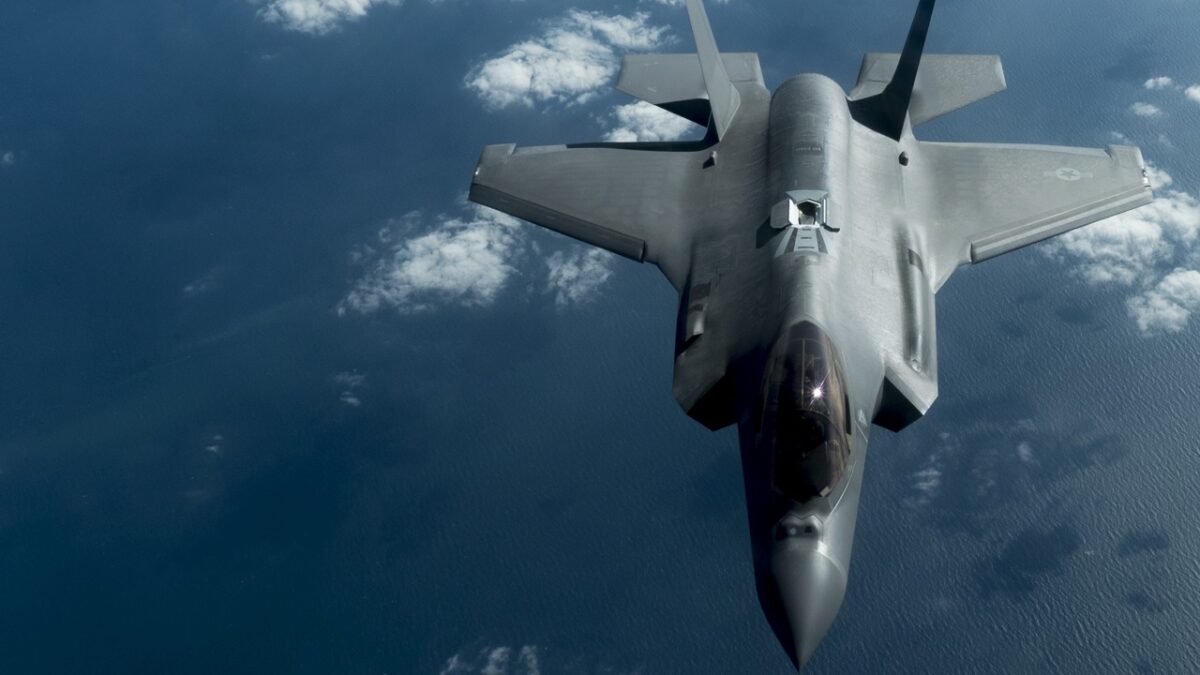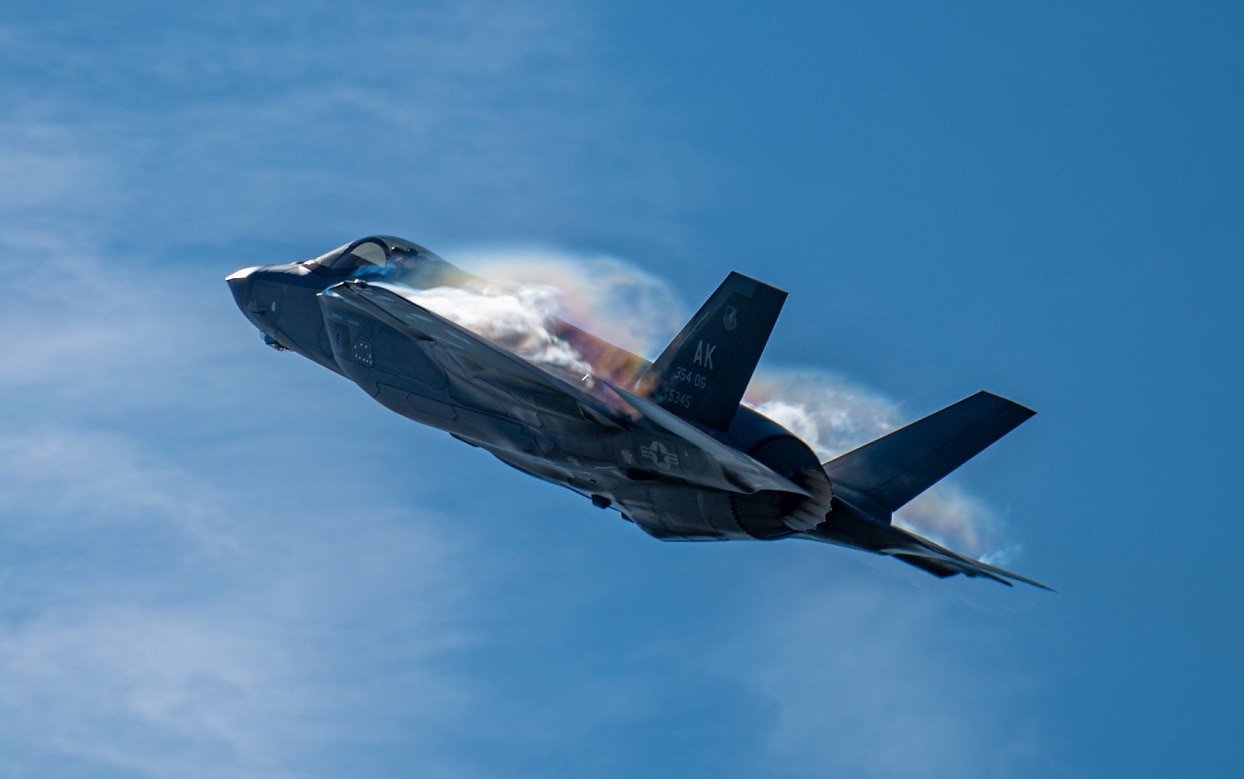The U.S. Air Force recently grounded its fleet of F-35 Joint Strike Fighters due to an issue impacting the airframe’s ejection seats.
As a pilot’s last line of defense during a mishap, the jet’s ejection seat system is critical – it must stay in working order. During a routine check in April, a potential problem came to light affecting the seat’s explosive cartridges, which help to propel the seat once ejection protocol is underway. The F-35 is the U.S. military’s premiere fifth-generation fighter, and it is flown by the Air Force, Navy, and Marine Corps. While the investigation continues, the Navy and Marine Corps have paused the use of the F-35B and F-35C.

A U.S. Air Force F-35 Lightning II aircraft, assigned to the 34th Expeditionary Fighter Squadron, flies over the U.S. Central Command area of responsibility, Jan. 07, 2019. The Lightning II is a fifth-generation fighter, combining advanced stealth with fighter speed and agility that provides U.S. Air Forces Central Command lethal war-winning airpower. (U.S. Air Force photo by Senior Airman Brandon Cribelar)
Failure to Eject
According to the Air Force Times, a spokesperson for seat manufacturer Martin-Baker said, “During a routine maintenance inspection at Hill [Air Force Base, Utah] in April ’22, an anomaly was discovered with one of the seat cartridge actuated devices in the F-35 seat.” During a routine inspection of an airframe’s interior in April, a maintainer felt that the ejection cartridge was suspiciously light. Further investigation revealed that the magnesium powder used to help propel a pilot from the plane was missing.
In a statement made this week, the Navy said that only airframes equipped with cartridges “within a limited range of lot numbers are affected.” Beginning on July 29, the Navy, Marine Corps, and Air Force have paused flights on several types of fixed-wing aircraft. However, Martin-Baker’s head of business development asserted that only F-35s have been impacted. According to Bloomberg News, the company added that, “Outside the F-35, not a single anomaly has been discovered worldwide as a result of the forensic investigation which continues at pace,” and said the initial problem discovered in April was “quickly traced back to a gap in the manufacturing process.”
From Stealth to Beast Mode
The F-35 Joint Strike Fighter is pretty much unanimously considered the most sophisticated and formidable fighter to ever fly. The fifth-generation multi-role jet is specialized in six mission sets: air superiority, strategic attack, close air support, electronic warfare, and suppression of enemy air defenses. To achieve air superiority, the F-35 can rely on its internal weapons bay to operate stealthily. While the airframe can only carry limited ammunition internally, this asset allows the jet to fly without tipping off adversarial aircraft.
As detailed by Harrison Kass in an article published by 1945, “The F-35 is limited to just 5,700 pounds of internal ordinance in stealth mode. For air-to-air missions, that’s just four AIM 120 AMRAAM missiles. And for air-to-air and air-to-surface hybrid missions, that’s just two AMRAAM missiles, plus two GBU-31 JDAM bombs. Not much. But at times, its necessary to evade detection.” When the F-35 no longer requires its stealth mode to function effectively, the fighter can transition into “beast mode,” which enables the airframe to carry nearly four times more ordinance.
Perhaps the F-35’s most sophisticated components are its cockpit and avionics systems. Featuring a panoramic cockpit display system, advanced helmet-mounted display, and an advanced avionics system, the F-35’s electronics are almost unbeatable. According to Popular Mechanics, an Air Force F-35 instructor pilot said, “There has never been an aircraft that provides as much situational awareness as the F-35. In combat, situational awareness is worth its weight in gold.”
The F-35’s advanced attributes have caught the attention of militaries worldwide. To date, Lockheed Martin has exported approximately 800 F-35 airframes across the globe. The U.S. Air Force remains the largest F-35 procurer, with Israel close behind. The Jewish state has agreed to purchase at least 50 F-35 fighters from Lockheed Martin by 2024. Following the U.S. Air Force’s grounding of its F-35 fleet, Israel’s Air Force Comm. Tomer Bar said the Israeli military would consider grounding its own arsenal in the upcoming days.
Grounding its fleet of F-35I Adir fighters would be extremely detrimental for Israel’s Air Force. As the first nation in the world to use the F-35 in combat, Israel uses its own variant of the advanced jet to perform critical operations. Last week, Israeli Defense Forces unveiled that it had used its F-35 airframes to intercept two Iranian unmanned aerial vehicles launched toward its borders. According to The Jerusalem Post, two Shahed 197 drones were destroyed.
As Iran ramps up its efforts targeting the Israeli state, the IDF will likely lean on the capabilities of its F-35I Adir fleet more regularly. Thus the temporary grounding of F-35s could be more consequential for Israel than it is for the U.S. Air Force.
Maya Carlin is a Middle East Defense Editor with 19FortyFive. She is also an analyst with the Center for Security Policy and a former Anna Sobol Levy Fellow at IDC Herzliya in Israel. She has by-lines in many publications, including The National Interest, Jerusalem Post, and Times of Israel.

